History of the Game Controller
by Dark Watcher |
|
Gamepads, Joysticks, Joy Pad, etc... They go by many names
and came in various styles and sizes, but controllers have always been the interface between the gamer and the game. They are the input devices
that accept gamer movements and manipulations, and convert it into data that the console can interpret. Just like the consoles that they belong
to, game controllers have seen numerous evolutions.
Early 1970s (particularly Pong units), the controllers were knob style and were built into the console deck. You were forced to play at the
machine. The knobs could be turned left or right and were interpreted by the consoles as onscreen up / down movement (or left / right movement
in some games).
They soon created controllers that you could be held in your hand, but the controller cords were hard wired into the console and the cord
length was limited. The hard wired cords also forced gamers to have to turn in entire consoles for repair if a controller became defective. Knobs were still popular until the eventual arrival of the Joystick.
Let's take a stroll through the history and evolution of the beloved game controller.
|
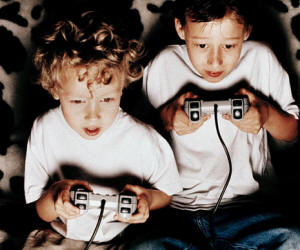 |
 The Early Days The Early Days
1976 through 1982 |
Joysticks allowed 8 directional digital movements (up/down/left/right/angles) with a
single action button. They were bulky with a heavy base, and a long protruding handle / stick that could be gripped in a fist. The Atari
2600 was one of the first machines to popularize joysticks. It was also one of the first controllers that allowed disconnection from the
console. This allowed gamers the ability to replace defective controllers. This also gave Atari 2600 the ability to use various other
controllers such as paddles and balls. These paddles were some of the early developments of analog control. Instead of movement translated
into digital signals, the analog controllers used potentiometers. These potentiometers could detect the speed of gamer paddle manipulations,
and translate it to an equivalent onscreen movement. The paddles were similar to the knobs, and only detected left / right or up / down movement. The ball controllers could recognize 4 directional analog movements. These controllers were the ideal choice for Pong / Breakout
styled games.
The Atari 2600 joysticks were not ergonomically friendly, and put some strain on the
wrist. Developers also noticed that the sticks would quickly become defective because of the grip and force exerted by excited gamers (good
thing that they could be replaced). This contributed to an early design change adopted by later consoles. The joystick would be changed to
have a smaller handle that could be manipulated by either the thumb or two fingers. This reduced the amount of force exerted by gamers. One
of the first consoles to adopt this redesign was the Bally Astrocade.
The Astrocade controller was quite innovative for its
time. It resembled the pistol grip of a gun, and even featured a trigger-like action button. The small joystick rested on the top of the pistol
grip. The joystick also featured a twistable knob that could be used for paddle games. Essentially the Bally Astrocade controller was
both analog and digital. While other controllers were adopting the use of smaller joysticks, Mattel Intellivision took the opportunity
to shake up controller evolution even further.
Rather then using a joystick, Intellivision used a metallic "circular direction disk"
that could be manipulated by the thumb. This "circular direction disk" used digital signals for recognition of up to 16 directions (8 more
then standard digital controllers). Mattel would also add 4 "side mounted" action buttons. The upper side buttons shared the same function,
but this allowed flexibility for both left and right handed gamers. Some consoles such as the Bally Astrocade and the RCA Studio
2 featured keypads mounted on the console. The functions of these keypads could be used for programming, or to effect game play. The
Intellivision incorporated the keypad into the controller. The keypad could be used to select different aspects of the game such as
difficulty and level selection (Start / Reset /etc). This freed gamers from the hassle of having to get up to start, select levels, or reset
from the console. Some games allowed the keypad to be used as part of game play, and overlays would be used to identify the game functions
of each button. The expanded features of the Intellivision controller did away with the need for other miscellaneous controllers (the
controllers were not removable in early models). Some loved it, and some hated it, but overall Mattel sparked a change in the evolution
of controllers. Quite a few consoles such as Colecovision borrowed many elements from the Intellivision design.
It was the 1980s and Atari had found a fierce competitor in the console market. The
rival console known as Intellivision possessed controllers that allowed for 16 directions of movement (and other features). Atari
decided to out do their competition with the creation of an analog joystick with 360 degree directional movement. The same analog potentiometer
technology previously used in paddles would find its way into the Atari 5200 controllers. The Atari 5200 controllers would also
feature a built in keypad, and sport 2 action buttons. Atari would also feature what would soon be commonly known as a "Pause" button
(the Intellivision had a similar "pause game play" feature by pressing "1" and "9" on the keypad). However, the same innovative step
towards analog control proved to be a handicap for Atari 5200 gamers. The analog control could not "self center". In other words, the
controller did not recognize a neutral position, and this translated to you game play where you can stay in one place (your always moving
in the last direction you moved).
|
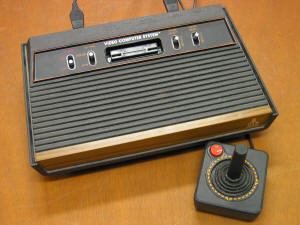
Atari 2600 Joystick Controller
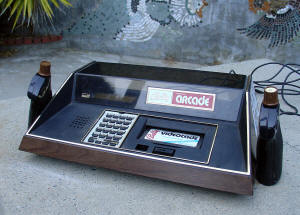
Bally Astrocade 'Pistol-Grip' Controller
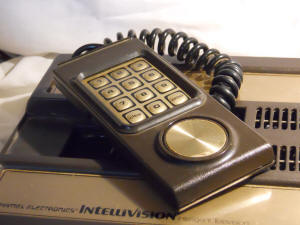
Mattel Intellivision "Directional Disc"
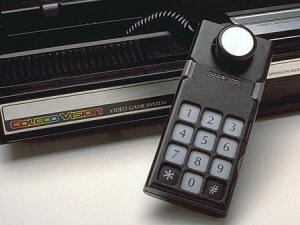
ColecoVision Controller |
|
Consoles such as Vectrex and Emerson Arcadia (and its many clones) would implement
"self-centering" and create analog joysticks that functioned correctly. The Vectrex would implement 4 action buttons, while the
Arcadia 2001 would borrow the keypad / side-button layout from the Atari 5200. Emerson would also borrow the "circular direction
disk" control from the Intellivision. In order to satisfy those who were familiar with joysticks (and not a thumb manipulated disk), Emerson Arcadia controllers had a screw hole in the center of the circular disk that allowed the addition of an optional joystick.
|
|
| A few more samples from this era |
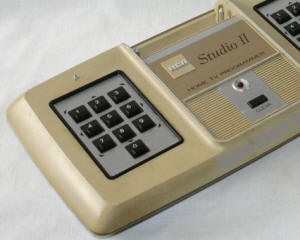
RCA Studio II Keypad |
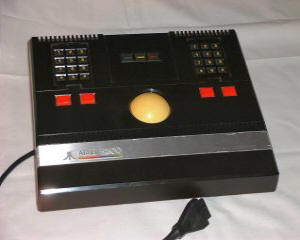
Atari 5200 Trackball Controller |
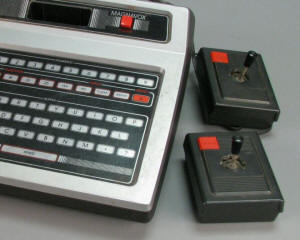
Magnavox Odyssey 2 Keyboard & Joysticks
|
|
 The D-Pad The D-Pad
1983 through 1999 |
During the early 1980s, a Japanese inventor named Gunpei Yokoi would create a controller
interface that would later become known as a D-Pad (Digital-Pad). This D-Pad used a "cross-shaped" directional digital control
interface that could be manipulated with the thumb (similar to Intellivision's "circular disk"). Nintendo truly popularized
the D-Pad in 1984/85 with the release of the Nintendo Famicom (NES).
The D-Pad allowed for 8 directional movements, and featured
2 action buttons. Two smaller buttons were incorporated to start, pause, and select game play options. The pads were designed to be small
enough to easily fit in a child's hands. Gunpei Yokoi's invention would revolutionize game controllers once again. Console manufacturers
would soon favor the use of JoyPads over the use of Joysticks.
Controllers soon started to develop more unique functions such as Slow Motion (manipulating
the pause / start button) and rapid fire (holding a button would simulate rapid button presses). Some of these had to be purchased as separate
accessories, but some consoles like the NEC TurboGrafx had the features built in. Developers also began to experiment with other forms
of game control. Nintendo for example used motion sensing technology (Power Glove / U-Force), but many did not catch on or had
limited use. Controller cords also became longer, and more flexible.
Between 1989 and 1990, JoyPads continued to borrow from the D-Pad concept. Sega introduced a 3rd action button with its Sega Genesis pad, and the controller was rounded off to ergonomically feel more comfortable
in the hands of gamers. An arcade fighter craze soon spurred the development of Sega's 6 button (3 top / 3 bottom) variations that
were sold separately (the fighter craze also seemed to bring back the popularity of Joysticks which are still prominently used in arcades. Gamers wanted to recreate the "arcade feel" of many "arcade to console" ports). Nintendo
answered the call with their own 6 button standard SuperNES controller.
The classic SuperNES controller strategically placed 2 action buttons on what would later be called "shoulder buttons". The SuperNES
pad was also rounded, and maintained a smaller size for children's hands. The appearance was almost dog biscuit shaped, and it allowed the
sides of the controller to be easily "cupped" by the hands. The "shoulder" buttons could easily be pressed by both index fingers. The other
4 buttons were placed angled, and mimicked the "cross-shaped" style of the directional pad. The idea was to make the buttons easily accessible
with the thumbs.
The big players (Sega / Nintendo) seemed to bring about even more new innovations
or led the way in overall controller designs. Many other consoles adopted similar controller layouts that were brought about by the Sega
/ Nintendo rivalry.
The 32-bit era had Sega debut their Saturn controller. It featured the same 6
button (3 top / 3 bottom) variation of their Genesis pad, but was slightly smaller to ergonomically suit gamers with smaller hands (an adoption
of Nintendo's policy). This time it was Sony who served as the as the developing rival.
The Sony PlayStation controller design used many elements from Nintendo's SuperNES pad. It featured the same "cross-shaped" 4 button layout, and took an additional
step of adding 4 shoulder buttons (for a total of 8 action buttons without counting the "Start / Select" buttons). The design was also extremely
friendly ergonomically, and took the concept of "cupping" the controller another step forward. The shape allowed the controller to not only
be "cupped", but also gripped comfortably with the hands.
Oddly enough, Atari decided to mix the designs of D-Pad controllers, and that of their numerical style classic controllers. The
result became the controller of the Atari Jaguar, which in many view as one of the worst controllers of all time.
Not to be outdone, Nintendo soon returned with their N64 controller. This time
Nintendo placed 6 buttons (4 "cross-shaped" style with an additional 2 buttons immediately to the left), 2 shoulder buttons, and a
button at the bottom that can be used like a gun trigger (similar to the trigger button from Bally's Astrocade). The controller featured
both a digital directional pad, and an analog joystick. The analog joystick not only allowed for 360 degree movement, but a characters movement
could either crawl / walk / run based on the amount of pressure that was placed on a particular direction. The mini joystick could be either
manipulated with two fingers, or be manipulated with the thumb like a digital pad. The design was almost trident like, and allowed for different
game play styles and grips.
The N64 pad took an additional step by featuring a slot to upgrade the features of the console. 2 features that
could be added was a "rumble pack" that caused the controller to shake during certain game play events (also called Force-Feedback),
and also a memory pack that allowed you to take your game saves from your console to another N64 owner's console (portable game saves).
Sony would later decide to add similar features to their controllers. The Dual Shock
PlayStation controller debuted in April of 1998. The pad design was similar to the original, but featured two analog joysticks in the
center. The Dual Shock also had built in rumble capability. An additional button was added to allow the gamer to turn analog mode on
or off. The joysticks could be either manipulated with two fingers like most joysticks, or be manipulated with the thumb like a digital pad
(since the joystick featured a rough rubber top). The joysticks could also be pushed down to serve as additional buttons (bringing the amount
of action buttons to 10).
|
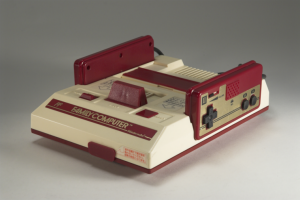
Nintendo Famicom
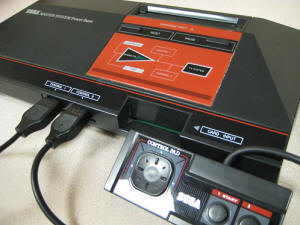
Sega Master System Controller
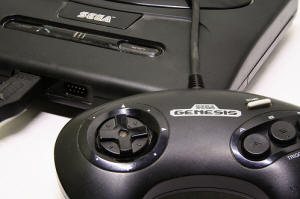
Sega Genesis Controller
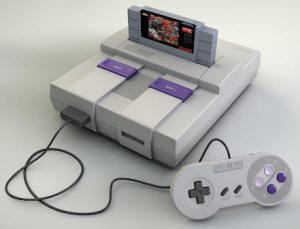
Nintendo SNES Controller
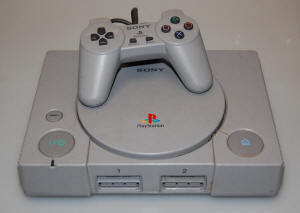
Sony PlayStation Controller
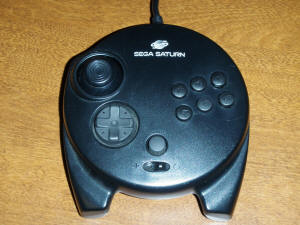
Sega Saturn 3D Control Pad |
In order to fuel the fires of innovation, Sega answered back and introduced their own
3D controller for the Sega Saturn. The Saturn 3D Control Pad (model
Sega MK-80117) was bundled with the game Nights
into Dreams (thanks Garrett!). The rounded controller contained an identical D-Pad and six button layout of the standard Saturn
controllers, but also featured an analog mini joystick that can be manipulated with the thumb (now referred to as 'Thumb-Sticks').
The analog joystick was placed directly above the D-Pad with the contour and handgrips allowing them to be accessible from the same side. There is also
a toggle switch similar to the PlayStation Dual Shock's "mode" button that allowed the gamer to switch between analog / digital game play. The cord was removable for storage purposes. What really set the stage in innovation was the Saturn 3D Control Pad featured
dual pressure sensitive analog trigger buttons. This feature was adopted into many of the controllers of 2000.
Other innovations occurred during this era including the first wireless controllers to be packaged as a standard (Memorex VIS)) and
multi-functional remotes like those used with the Philips CD-i and Commodore CDTV. Also, who could forget the glamorous appeal of
the Panasonic 3DO which introduced us to (and thankfully never duplicated) the 8-way daisy chain concept of gaming.
The 1980s and 1990s were definitely a time for significant growth and evolution of the gamer controller. Would the new millennium prove to be the
same? Read on to find out...
|
|
| A few more samples from this era |
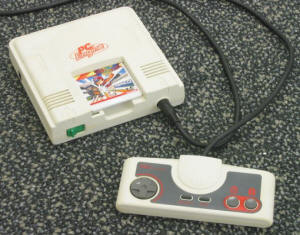
NEC
PC Engine Controller |
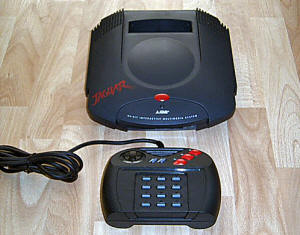
Atari Jaguar Controller |
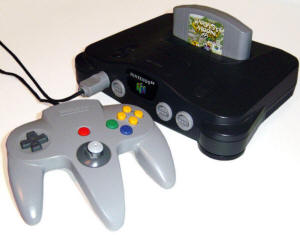
Nintendo 64 Controller
|
|
 More Buttons! More Buttons!
2000 through 2004 |
Ah..the 128-bit era...
With the Dreamcast console, Sega took
the best features of their Saturn 3D Control Pad to include the analog thumb-stick and D-Pad combination, pressure sensitive triggers
and interesting enough the bulky size and grips. Sega also took the upgrade slot feature of the Nintendo 64 pad, but expanded
on the feature so it could be used for save games (VMU) or a rumble pack. Each controller had two upgrade slots. Sega chose
to also go with the "cross-shape" button layout that had become the controller staple (like the D-Pad). A new feature added by Sega
was a small screen display for use with the Sega VMU. The small screen could be used as a private screen and could show small graphics
and statistics.
Sony came onto the scene shortly after with
its PlayStation 2. The controllers had the exact design as their Dual Shock for PlayStation, but featured pressure sensitive
analog buttons. Game play could now be based on how hard you pressed a button (for example an onscreen character could throw a soft jab if
you tap a button, but throw a hard punch if he press and hold the same button).
Microsoft later debuted its Xbox controller. It incorporated the PS2's rubber topped "Push button" analog mini joysticks (Now called a "Thumb-Stick") and internal rumble
features. It also featured an upgrade slot similar to N64 and Dreamcast for portable game saves. It also featured the two trigger
button layout similar to the Dreamcast, and used the standard 4 button cross-shaped layout with 2 additional buttons placed below. The placement of the digital pad and analog sticks were switched compared to the PS2 controller. The digital pad was no longer on the
traditional far left, but was now placed towards the left-center. The Xbox controller did add one unique feature. The cords were made
even longer then standard (9 feet), and had a "break away" connector to prevent the console from being pulled if the cord is snagged or stepped
on. There were complains about the original controller size, but Microsoft later released an S-Type controller to meet the needs
of smaller hands.
Nintendo stepped up to once again try and
revolutionize gaming controllers. The Nintendo GameCube controller pretty much featured the same digital pad and 2 analog thumb sticks
like the Xbox and PS2 pads. It also featured built in rumble capabilities. Nintendo also elected to switch the placement
of the digital and analog pads (same as Xbox). Nintendo also did away with the upgrade slot. The GameCube controller
design is made with more emphasis on ergonomics. The controller is shaped for good grip even with small hands (grips similar to Sony's
Dual Shock). They added an oversized "A" button, standard "B" button, and curved "X and Y" buttons. The layout was meant to eliminate
the need for a gamer to ever glance at the controller by offering a "home" button with the others just a roll of the thumb away. The shoulder
buttons have been contoured for comfortable finger access. The shoulder buttons are also pressure sensitive analog (like PS2), but
have a digital-click function. This allows each shoulder button to act like 2 action buttons. Simply press normal for an analog action or
push all the way till it clicks for a digital action. Nintendo added an additional shoulder button on the right side to serve as a
"Z" button.
|
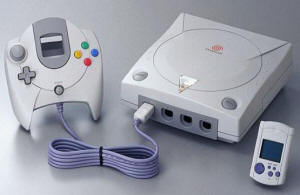
Sega Dreamcast with VMU
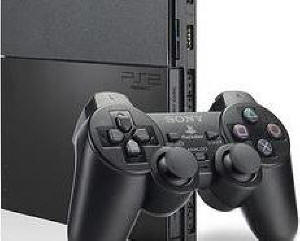
Sony PlayStation 2
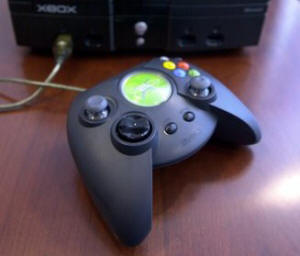
Microsoft Xbox |
|
All three of the current consoles offer similar features
and capability, but ergonomic and game play factors vary depending on type of game and the game player. All in all it is interesting how controllers
have evolved. All of the controllers used today have borrowed features from a previous console's controller design. It will be interesting
to see how controllers evolve in the near future. In the meantime, check out the evolution of another aspect of controllers. The evolution
of wireless controllers...
|
|
| A few more samples from this era |
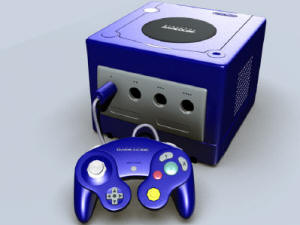
Nintendo GameCube Controller |
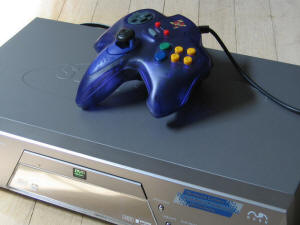
NUON Controller |
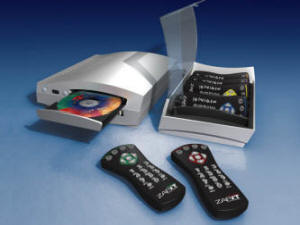
ZAPiT Game Wave Controller
|
|
 Wireless Controllers - The Beginning Wireless Controllers - The Beginning |
Gamers really had it bad in the early 1970s. They had to play on a controller that was built into the console. Things got
better for gamers when game controllers began to feature cords that would let them play away from their console. Controller cords made gaming
easier, but brought their own share of problems. The controller cords could become entangled. They also became tripping hazards. Nothing could
be worse then having the dog (or some young blind sibling or cousin) trip on your cord and either knock down your precious console, or destroy
any progress you had made in a particular game. Some gamers would grow tired of being leashed like dogs to their game console (cords ranged
from 3 to 9 feet in length). It would be inevitable that cordless / wireless gaming would become the next stage of controller development.
Wireless game controllers have actually been around for quite some time. Atari experimented with wireless technology in the early 1980s. A prototype wireless system called the Atari 2700 never saw the light of day, but the same Radio Frequency (RF) technology was used for a
set of wireless joysticks for the Atari 2600.
Atari's CX-42 wireless joysticks used the same RF frequency range used for garage door openers, walk-talkies, or radio controlled cars
/ planes (27 MHz or 49 MHz). The controller movements would transmit signals to a receiver that connected to your Atari 2600. The concept
did in fact give gamers the freedom to move at ranges of 20 to 30 feet from the receiver. However, the controllers were large and bulky. The
receiver had to be plugged into an AC wall outlet, and each joystick required a 9V battery. Other then the complaints about the bulkiness,
gamers complained about poor battery life and controller lag (slow on screen responses to gamers controller movements). We would not have
been surprised if there were also complaints about garage doors randomly opening (hehe).
Between the mid 1980s and early 1990s game controllers evolved to include more button inputs. Developers continued their pursuit for
wireless gaming, but required something to produce better results. They abandoned Atari's use of RF technology in favor on the same infrared
technology used on remote controls prevalent with televisions and VCR / DVD players.
Infrared (IR) controllers provided the ability to play games wirelessly at up to 25ft (762cm). The commands were transmitted to a sensor
mounted on your console and would not effect any other appliances (garage owners breathes a sigh of relief).
IR controllers also had their own deficiencies. The controllers required an uninterrupted line of sight between the controller and the
machine. This meant that you would lose control if something (or someone) got between you and your console. It also meant that you had to
point the controller directly at the sensor.
There were many 3rd Party developed IR controllers (examples: Acclaim & MadCatz), but some official IR controllers were Nintendo's NES
Satellite and Sega's MK-1646-50 model II for Genesis.
IR wireless controllers continued to be used well into 2000, but the technology would fail to meet the requirements of newer consoles. Controllers began to feature more functions and capabilities, and infrared could not handle the higher data transfer requirements needed. Also infrared could only transfer data in one direction (controller to sensor), so features such as "Force Feedback" (rumble) could not be
reproduced (console sends the signal back to the controller to initiate rumble). Developers would once again use RF technology for wireless
controllers. It just happened to be the same technology being used with cordless phones.
Developers began to use the regulated frequency ranges of 902 to 928 MHz (433.050 to 434.790 MHz and 869.700 to 870.000 MHz in European
countries). These frequency ranges allowed a higher two-way data transfer that was omni-directional (doesn't have to be pointed directly at
sensor) and had 4 or more available channels for multiple controller usage. One of the first controllers to debut with this technology was
a 3rd party controller (AirPlay) for the Sony PlayStation.
|
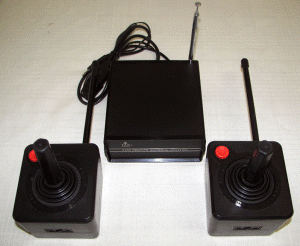
Atari CX-42
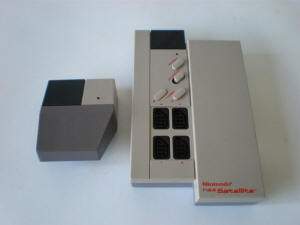
NES Satellite
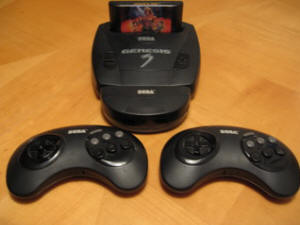
Sega Genesis
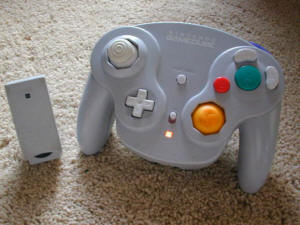
Nintendo WaveBird controller |
It was only a matter of time before developers would take advantage of the higher 2.4 GHz frequency Wi-Fi (Wireless Fidelity) technologies. The high data rate capability and refresh rates corrected the past issues of lag. The frequency range also required less power, and so battery
consumption issues were addressed. Gamers could now have their wireless gaming up to 30 feet away without any issues.
There are quite a few 3rd party companies that have produced 2.4 GHz wireless controllers, but Nintendo was the first console developer
of this time to debut their own WaveBird controller for GameCube.
So what new wireless developments will surface in the future? The current technology is reliable, but has its own issues (some conflicts
may occur if controllers are within the frequency range of computer wireless networks or 2.4GHz cordless phones). Bluetooth perhaps? Read
on... |
|
| A few more samples from this era |
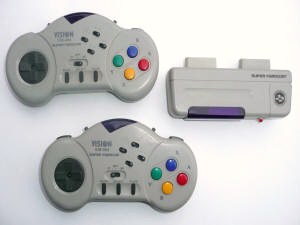
Super Famicom Wireless Controllers |
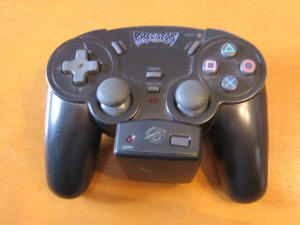
Predator Wireless for PlayStation 1 |
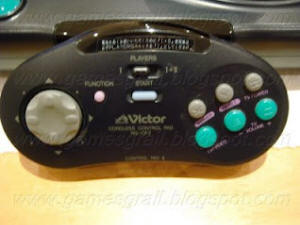
Victor WonderMega Wireless Controller
|
|
 Wireless Controllers - Advanced Wireless Controllers - Advanced |
Microsoft entered the 7th generation of console gaming with the knowledge that 2.4 GHz Wi-Fi still had much to offer. The Xbox 360
controller uses a proprietary Wi-Fi protocol that can sync up to four (4) controllers. Their Xbox 360 controllers shared the same button
layout, thumb sticks, triggers and force feedback as their original Xbox S type controller. However, they made great improvements on the
ergonomic feel. Their new controller also features an additional button for direct Xbox Live access and a headset jack for in game
communications. A proprietary USB connector (which is split into 2 parts on either side of the headset connector) also allowed for the use
of additional accessories. The controller can work wirelessly up to 30 ft (914 cm) and can run up to 40 hours on 2 "AA" batteries. However, that leads to a lot of disposable batteries. Microsoft sold a "Charge & Play" pack separately which allowed for a rechargeable
battery pack. The controller even works on Windows based PC gaming. In November of 2010, Microsoft released a controller pack that
included “Charge & Play” and a modified controller QFF-00005. The matte silver controller featured concaved thumb sticks and a special
transforming digital pad. The digital pad can be changed from the original 'disc' format (that allows for sweeping moves) to a 'plus'
format (the tried and true D-Pad look that allows for better cardinal direction moves) best used for games in the fighting genre. The
controller can run up to 35 hours of game play, but can also be charged via USB while playing.
Microsoft may have chosen to stick with Wi-Fi, but their console competition would decide on using a different wireless technology. Bluetooth is a wireless protocol utilizing short-range communications to transfer data over short distances from fixed and/or mobile
devices. So what makes it different? It uses 2.4 GHz frequencies just like Wi-Fi, but Bluetooth uses different modulation techniques. Bluetooth avoids other devices like cordless phones and Wi-Fi networks by dividing communications into 79 channels that change up to 1600
times per second. While Wi-Fi was primarily designed for wirelessly networking computers, Bluetooth was designed to act like an invisible
cable connecting devices. It can create wireless personal area networks (PANs) with one master device communicating with 7 other devices. It uses very little power and easily connects other Bluetooth devices by "discovering" them when near each other. No fancy configuration
is needed.
Sony decided to take advantage of Bluetooth technology for their PlayStation 3 console. Their initial controller release was called
SIXAXIS. The controller used Bluetooth 2.0, which gives the controller the ability to operate wirelessly at a distance of approximately 32
ft (10 Meters). The Bluetooth features allowed the PS3 to have up to seven (7) controllers operating wirelessly and provided good
controller battery life for up to 30 hours. It featured a rechargeable battery that can be charged during game play using a USB cord. The
SIXAXIS resembles the DualShock 2 controller, but features better analog sensitivity. The controller's L2 / R2 buttons were also modified
to work more like triggers. The old "Analog" mode button was also replaced with a jewel-like "PS" button that can be used to access menus
or to turn the system on or off. LED lights were also added as indicators for charging or identifying players. The biggest deviation from
the DualShock 2 controller design was the removal of "Force Feedback" (rumble) support. Sony would later remedy this with the release of
DualShock 3. The most unique innovation featured in both the SIXAXIS and DualShock 3 is motion-sensing capabilities. The controllers
contain a gyroscopic sensor and an accelerometer that can translate yaw, pitch and roll into onscreen action. In other words, the sensor
can detect the angle you tilt the controller in your hands and also how fast you are doing it. This added a new dimension of game play.
The 7th Generation also took the concept of motion-sensing technology to the next level. The idea of using actual body movement to
interact with games has seen failed experiments as early as the 1980s (NES Power Glove, Sega Activator, Power Pads, etc). Newer and
cheaper technology would see motion gaming done right. Using cameras and infrared sensors (identified location / visual position,
recognition, distance and depth), accelerometers (senses speed of motion on 3-axis up, down, left, right, forward and backward), gyroscope
sensors (senses orientation and rotation) and Magnetometers (typically used in GPS devices, to determine direction using the Earth's
magnetic field).
Nintendo has always been at the forefront of controller innovations, but their entry into the 7th Generation of consoles shocked many. Rather then a traditional controller design, the Nintendo Wii controller resembles a TV remote control (thus the name Wii Remote or
Wii-mote). It was designed for single-handed game play, features a D-Pad near its tip, an enlarged "A" button and a trigger "B" button
underneath. The traditional "Start" and "Select" buttons were changed to plus ("+") and minus (”-“) and the "Y" and "Z" buttons were
changed to "1" and "2" to differentiate them from the "A" and "B" buttons. The button layout works for easy button access, but also
functions as a classic controller when the Wii-Mote is turned sideways. Blue mounted LED lights indicate what player you are and also
function as battery life indicators. The Wii-Mote is powered by two "AA" batteries with a reported 30 hour play life on average.
The Wii-Mote also uses wireless Bluetooth 2.0 and motion-sensing technologies, but takes it an additional step forward. Nintendo added
a PixArt optical sensor at the tip, allowing it to determine the direction you are pointing the controller. The optical tip communicates
with an included Wii Sensor Bar that is mounted above or below your television and uses tried and true infrared technology. The Wii-Mote
also features a 3-axis accelerometer. All that "tech magic" means is that the Wii-Mote can translate your movements into on screen action. Swing the controller like a sword, or a baseball bat and the Wii replicates the action on screen. Good thing Nintendo included straps for
those excited gamers with sweaty hands and limp wrist grips. |
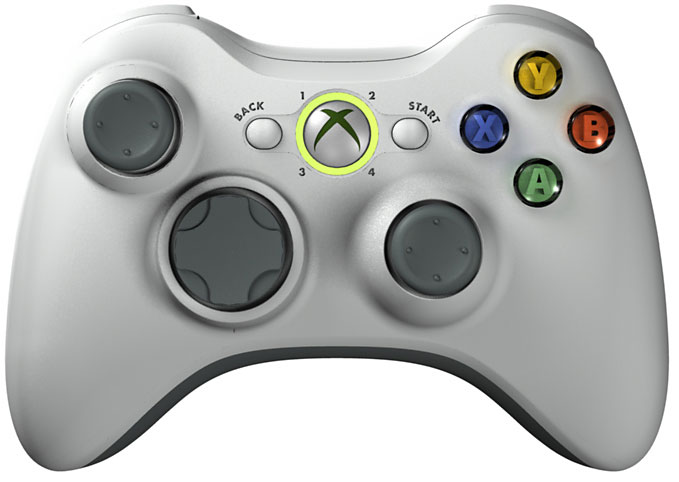
Microsoft Xbox 360 - Original Version
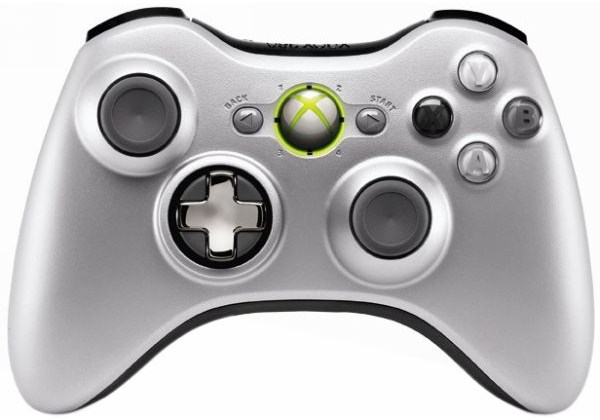
Microsoft Xbox 360 - Version 2
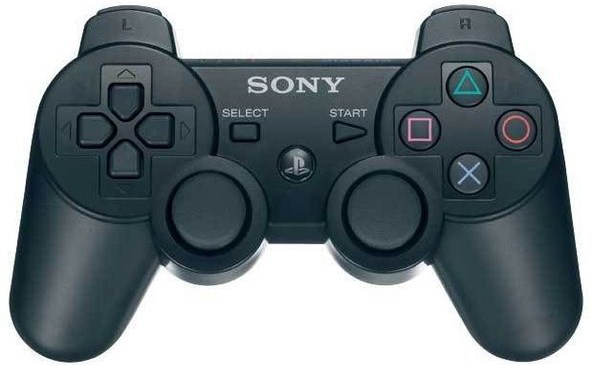
Sony PlayStation 3 DualShock 3
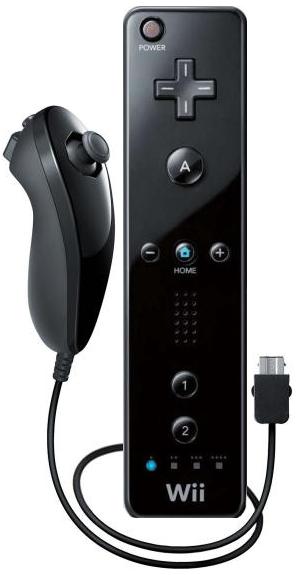
Nintendo Wiimote + Nunchuk |
Nintendo also lumped in force feedback (rumble) and an independent speaker on the face of the unit for special game sound effects. Nintendo must have wanted to cement their title as controller innovators because they also included 16 KB of memory with 6 KB that can be
freely read and written by the Wii. This can be used to store Mii avatars, game controller configurations or whatever else creative
programmers come up with into the Wii-Mote. They also added an expansion port at the bottom to attach additional devices like their pack
in Nunchuk analog stick (that features its own motion-sensing accelerometer), the Wii Classic Controller and more. The Wii-Mote can
operate as far as 10 meters (30ft) for games that don't require the sensor bar and 5 meters for games that do.
|
 Motion Sensing Motion Sensing |
Nintendo has definitely upped the anti as far as controller innovation. Their efforts made motion controlled gaming mainstream. Their Wii
console attracted a previously untapped audience of casual gamers both young and old. It only made sense that the competition would want a
piece of the action. However, it was time for the next level. Gamers wanted total immersion. They wanted to genuinely feel like they were
truly in the game.
Nintendo made motion gaming fun, but their Wii-Mote controller did not exactly translate 1:1 movement to onscreen game action. Literally, a flick of the wrist from your couch could score you a home run in Wii Sports. While this works for lazy gamers, it did not
represent true game immersion. In June of 2009, Nintendo addressed this by releasing Wii MotionPlus. The MotionPlus add-on incorporates a
dual-axis tuning fork gyroscope and a single-axis gyroscope with a pass-through expansion port so that all your other devices will still
work (although the added length would not allow the controller to fit in all those plastic shell accessories). In November of 2010,
Nintendo would release Wii Remote Plus, which is basically the Wii-Mote with Wii MotionPlus built in.
Sony began their attempts at game immersion by upgrading a device originally designed for their PlayStation 2 console. In 2007, they
released the PlayStation Eye for PlayStation 3. The PlayStation Eye is a RGB camera capable of capturing standard video with frame rates
of 60 hertz at a 640 x 480 pixel resolution and 120 hertz at 320 x 240 pixels. In addition to standard video capabilities, it has features
such as motion tracking, color tracking, edge detection, gesture recognition, computer vision based head tracking and facial recognition /
analysis. The PlayStation Eye also features a built-in four-capsule microphone array that is capable of sound location tracking, echo
cancellation, noise suppression and speech recognition.
In September of 2010, Sony released the PlayStation Move. If the Nintendo Wii and Microsoft Kinect (more on that later) had a bastard
child then it would be Move. Sony essentially took all the technology of their Dual Shock 3 (including Bluetooth, Haptic Feedback,
rechargeable battery, gyroscope sensor, accelerometers, etc) and molded it into a wand controller akin to the Wii remote. The Move, which
looks like a microphone, also includes an additional magnetometer to determine the controller's orientation. By itself, the PlayStation
Move is an impressive motion controller. However, the Move was designed to work with the PlayStation Eye. At the top of the Move
controller is a fuzzy orb that can glow in a full range of colors using RGB light emitting diodes (LEDs). The orb shape and light
leverages the PlayStation Eye's motion tracking ability. The PlayStation Eye can determine the Move controller's location and distance
based on the Move's orb shape and color. The Eye also recognizes the gamer and how the controller is in relation. The Move's built-in
sensors and the Eye's recognition library give the controller high precision and movement accuracy in 3D space. For example, the
PlayStation 3 can determine the location of the controller even if hidden behind your back. The light colors can be used to identify up to
four (4) simultaneous Move controllers, or be used for visual effects like gun muzzle flash.
Like the Wii-Mote, the PlayStation Move features its own nunchuk sub-controller. The navigational controller communicates wirelessly
via Bluetooth and replicates the functions of the left side of a DualShock controller. It is sold separately and offers more game play
options. The PlayStation Move coupled with Eye allows for many immersive gaming possibilities.
Microsoft would not be left out of the motion controller game. They released their Kinect for Xbox 360 in November of 2010. Kinect
sticks to its ad line of making you the controller. Kinect is a camera based interface similar to PlayStation Eye, but taken to another
level. Kinect features 3D motion capture, facial recognition and advanced gesture recognition. It has a four microphone array that is
capable of sound location tracking, echo cancellation, noise suppression and speech recognition.
For the most part it may sound like the features of the PlayStation Eye, but what sets Kinect apart is its use of multiple cameras. Kinect has a RGB camera capable of capturing standard video with frame rates of 30 hertz at a 640 x 480 pixel resolution, but also has a
monochrome CMOS (Complimentary Metal-Oxide Semiconductor) camera that is combined with an infrared laser projector. Both work together to
see and map a room in 3D (light coding) regardless of the lighting conditions.
|
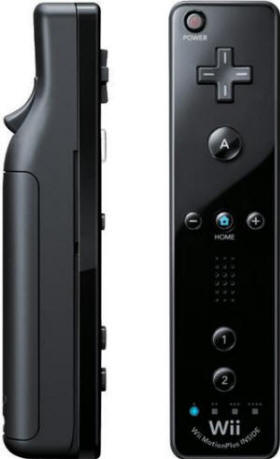
Nintendo Wii Remote Plus
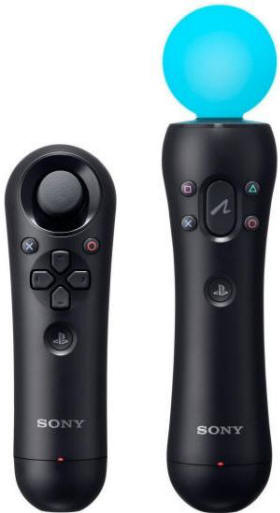
Sony PlayStation Move + Navi Controller |
Behind the Kinect hardware is a remarkable software library that is not only capable of mapping the room your playing in, but also do a
3D scan of the gamer. Kinect is programmed to distinguish human body parts, joints and movements, as well as the ability to distinguish
individual human faces from one another. It does this by mapping forty-eight (48) points in each players body to include facial details. Kinect can also track the motion of up to twenty (20) skeletal joints per player and recognize six (6) players onscreen.
Controllers will continue to evolve and improve. The introduction of touch control interfaces are already being incorporated into
consoles. It will be interesting to see what new innovations appear on the horizon.
|

Microsoft Kinect
|
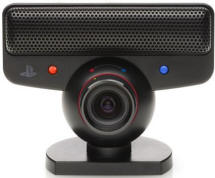
Sony PlayStation Eye |
|
 The Early Days
The Early Days









 2010s - NOTES
2010s - NOTES




 The D-Pad
The D-Pad








 More Buttons!
More Buttons!





 Wireless Controllers - The Beginning
Wireless Controllers - The Beginning






 Wireless Controllers - Advanced
Wireless Controllers - Advanced



 Motion Sensing
Motion Sensing



 DISCUSS
DISCUSS